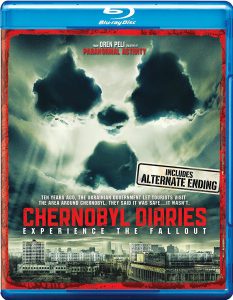“Chernobyl Diaries” is a great launch to the summer horror movie season, a spooky journey through a ghost town, a blue-collar burg with bland government-style architecture that was quickly abandoned three decades ago in the wake of the next-door Chernobyl nuclear disaster. I don’t think it’s a spoiler to say that the town might not be so empty after all.
However, the emptiness when the “extreme tourists” — four Americans, two Europeans and their Ukranian guide — first explore the city is what’s really creepy and unusual about “Chernobyl Diaries.” The acting’s good enough (Jesse McCartney of “Summerland,” who was the next big thing a half-decade ago, is the only recognizable face), the character relationships are standard (bickering brothers, young lovers, bonding strangers) and the scare scenarios are guided by a deft hand. There’s only one “No, don’t go out there!” moment. Otherwise, the situation escalates in a tense, believable way. (Also, the little things are explained, such as why no one is wearing radiation suits: A couple hours of radiation won’t hurt them.)
The initial nothingness of the town is a big reason why “Chernobyl Diaries” works, but the absence of something else makes it great, too: This isn’t a “found-footage” film. Writer Oren Peli, who developed a reputation as a talent in this subgenre with his “Paranormal Activity” franchise, makes the right choice to shoot “Chernobyl” traditionally, with the camera not being held by a character. As I argued throughout his short-lived TV series “The River,” if it had been shot traditionally, it would’ve been much better. “Found footage” works (except for a questionable sequence at the end of the third movie) on the “Paranormal” films because the plot naturally allows for it, but anytime a viewer thinks “Why in the world is he still filming that?!,” it ceases to be effective.
There is one sequence in “Chernobyl” where a character finds a dropped smartphone that had been recording; it’s a nod to the writer’s “Paranormal” roots and also a nice storytelling device at that moment, but I’m glad I didn’t have to watch the whole movie that way.
Another advantage to traditional camera work — a mix of hand-held and mounted cameras in “Chernobyl” — is that the cinematographer (and later, the editor) can linger on a location longer, thus creating a sense of place and setting a mood. The movie, shot in Serbia and Hungary, really does give a sense of an eastern European ghost town that’s simultaneously vast and a bit claustrophobic (due to the radiation, the tourists mustn’t wander too far from the safety of the van). And I’m glad I got to see that with the characters, through their eyes, rather than through their video footage.
What are your thoughts on the first big horror flick of the summer?

